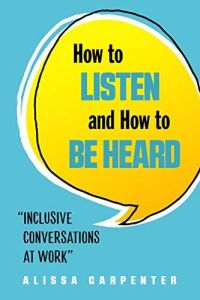Melden Sie sich bei getAbstract an, um die Zusammenfassung zu erhalten.

Melden Sie sich bei getAbstract an, um die Zusammenfassung zu erhalten.
Alissa Carpenter
How to Listen and How to Be Heard
Inclusive Conversations at Work
Career Press, 2020
Was ist drin?
Inclusive companies perform better and their workers are more engaged. Unlock this potential at your firm.
Recommendation
Companies with diverse, inclusive workplaces perform better. Their employees are more engaged and more productive. Workplace expert Alissa Carpenter explains how to improve your firm’s inclusivity. Her practical, applicable advice on handling challenging conversations, turning differences into strengths and overcoming bias is relevant to any manager. While some points may seem obvious – such as seeking opportunities to interact with your colleagues in person – they are also poignant reminders about the value of personal connection and perhaps about the potential of the hybrid in-and-out of the office model.
Summary
About the Author
Multigenerational workplace expert Alissa Carpenter owns Everything’s Not OK and That’s OK, where she provides training, consulting and speaking services.


















Comment on this summary